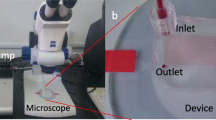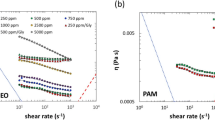Abstract
Accurate measurement of viscosity using small samples is important considering the role of viscosity in the dynamics of physical, chemical, and biological systems. The microfluidic viscometer proposed in previous studies can measure the viscosity of fluids by estimating the pressure between samples and reference flows from the interfacial width. Therefore, accurate detection of the interfacial width is important in terms of the performance of a viscometer. We investigate flow behaviors in the microfluidic viscometer depending on their shape. In the simulation results, sample and reference flows are accelerated around the sharp corners of the viscometer. Flow disturbance around corners results in regions with a high-shear rate. The area of the high-shear region becomes wider as the confluence angle increases. To experimentally check the variation of flow conditions depending on the confluence angle, the flow rate and interfacial width were measured in a microfluidic viscometer designed using mold fabricated with a 3D printer. The width ratios obtained from the experiment results are varied depending on the confluence angle of the viscometer. This indicates that a high-shear region around a sharp corner can lead to inaccurate measurement of the microfluidic viscometer. To reduce the high-shear regions, the distributions of the shear rate were investigated depending on the degree of the rounded corners. A region with a high-shear rate is significantly decreased by increasing the radius of curvature. From the results, a microfluidic viscometer with a confluence angle of 30° and rounded curves is suitable for measuring the viscosity based on an estimation of the pressure. By using the selected design of the microfluidic viscometer, the viscosity of a blood sample is reasonably measured depending on the shear rate. A microfluidic viscometer with a suitable design can be utilized as a viscometer with significant advantages in terms of mobility and ease of operation by combining it with mobile sensing equipment.
Graphical abstract










Similar content being viewed by others
References
Allmendinger A, Dieu LH, Fischer S, Mueller R, Mahler HC, Huwyler J (2014) High-throughput viscosity measurement using capillary electrophoresis instrumentation and its application to protein formulation. J Pharm Biomed Anal 99:51–58
Cho YI, Hartnett JP, Lee WY (1984) Non-newtonian viscosity measurements in the intermediate shear rate range with the falling-ball viscometer. J Non-Newton Fluid Mech 15:61–74
Gent AN (1960) Theory of the parallel plate viscometer. Br J Appl Phys 11:85
Groisman A, Steinberg VV (2000) Elastic turbulence in a polymer solution flow. Nature 405:53–55
Guillot P, Panizza P, Salmon JB, Joanicot M, Colin A, Bruneau CH, Colin T (2006) Viscosimeter on a microfluidic chip. Langmuir 22:6438–6445
Guillot P, Moulin T, Kotitz R, Guirardel M, Dodge A, Joanicot M, Colin A, Bruneau CH, Colin T (2008) Towards a continuous microfluidic rheometer. Microfluid Nanofluid 5:619–630
Gupta S, Wang WS, Vanapalli SA (2016) Microfluidic viscometers for shear rheology of complex fluids and biofluids. Biomicrofluidics 10:043402
Jung SY, Yeom E (2017) Microfluidic measurement for blood flow and platelet adhesion around a stenotic channel: effects of tile size on the detection of platelet adhesion in a correlation map. Biomicrofluidics 11:024119
Kang YJ, Yoon SY, Lee KH, Yang S (2010) A highly accurate and consistent microfluidic viscometer for continuous blood viscosity measurement. Artif Organs 34:944–949
Kim H, Cho YI, Lee DH, Park CM, Moon HW, Hur M, Kim JQ, Yun YM (2013) Analytical performance evaluation of the scanning capillary tube viscometer for measurement of whole blood viscosity. Clin Biochem 46:139–142
Kim S, Kim KC, Yeom E (2018) Microfluidic method for measuring viscosity using images from smartphone. Opt Lasers Eng 104:237–243
Krieger IM (1968) Shear rate in the couette viscometer. Trans Soc Rheol 12:5–11
Lee S, Kim KJ (2006) Design of ipmc actuator-driven valve-less micropump and its flow rate estimation at low reynolds numbers. Smart Mater Struct 15:1103–1109
Liu M, Xie S, Ge J, Xu Z, Wu Z, Ru C, Luo J, Sun Y (2016) Microfluidic assessment of frying oil degradation. Sci Rep 6:27970
Srivastava N, Burns MA (2006) Analysis of non-newtonian liquids using a microfluidic capillary viscometer. Anal Chem 78:1690–1696
Yeom E, Lee SJ (2015) Microfluidic-based speckle analysis for sensitive measurement of erythrocyte aggregation: a comparison of four methods for detection of elevated erythrocyte aggregation in diabetic rat blood. Biomicrofluidics 9:024110
Yeom E, Kang YJ, Lee SJ (2014a) Changes in velocity profile according to blood viscosity in a microchannel. Biomicrofluidics 8:034110
Yeom E, Nam KH, Paeng DG, Lee SJ (2014b) Improvement of ultrasound speckle image velocimetry using image enhancement techniques. Ultrasonics 54:205–216
Yeom E, Nam KH, Paeng DG, Lee SJ (2014c) Effects of red blood cell aggregates dissociation on the estimation of ultrasound speckle image velocimetry. Ultrasonics 54:1480–1487
Yeom E, Kang YJ, Lee SJ (2015) Hybrid system for ex vivo hemorheological and hemodynamic analysis: a feasibility study. Sci Rep 5:11064
Yeom E, Byeon H, Lee SJ (2016a) Effect of diabetic duration on hemorheological properties and platelet aggregation in streptozotocin-induced diabetic rats. Sci Rep 6:21913
Yeom E, Park JH, Kang YJ, Lee SJ (2016b) Microfluidics for simultaneous quantification of platelet adhesion and blood viscosity. Sci Rep 6:24994
Yeom E, Kim HM, Park JH, Choi W, Doh J, Lee SJ (2017) Microfluidic system for monitoring temporal variations of hemorheological properties and platelet adhesion in LPS-injected rats. Sci Rep 7:1801
Acknowledgements
This work was supported by the National Research Foundation of Korea (NRF) Grant funded by the Korea government (MSIP) (NRF-2016R1C1B2014255 and 2017R1C1B5018423) and supported by Pusan National University Research Grant, 2016.
Author information
Authors and Affiliations
Corresponding authors
Electronic supplementary material
Below is the link to the electronic supplementary material.

Supplementary Fig. 1
3D inlet and outlet conditions and 3D streamline in the microfluidic viscometer with a confluence angle of 90°. Flow rates of both flows are fixed as 1 mL/h. (JPEG 364 kb)
Rights and permissions
About this article
Cite this article
Kang, D., Song, J.M. & Yeom, E. Design of microfluidic viscometer based on pressure estimation. J Vis 22, 25–34 (2019). https://doi.org/10.1007/s12650-018-0524-0
Received:
Revised:
Accepted:
Published:
Issue Date:
DOI: https://doi.org/10.1007/s12650-018-0524-0




